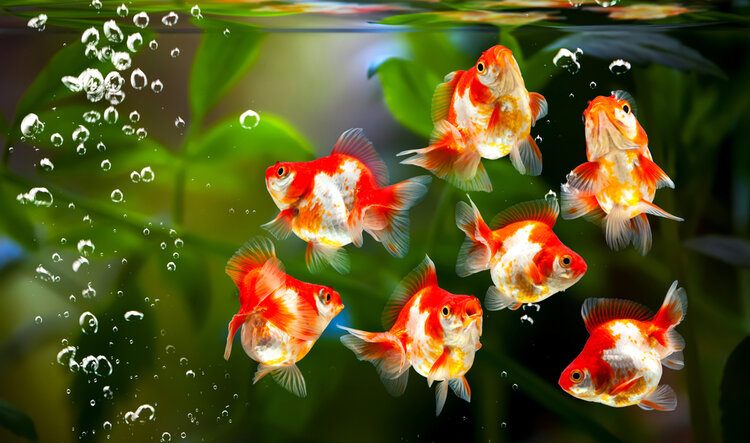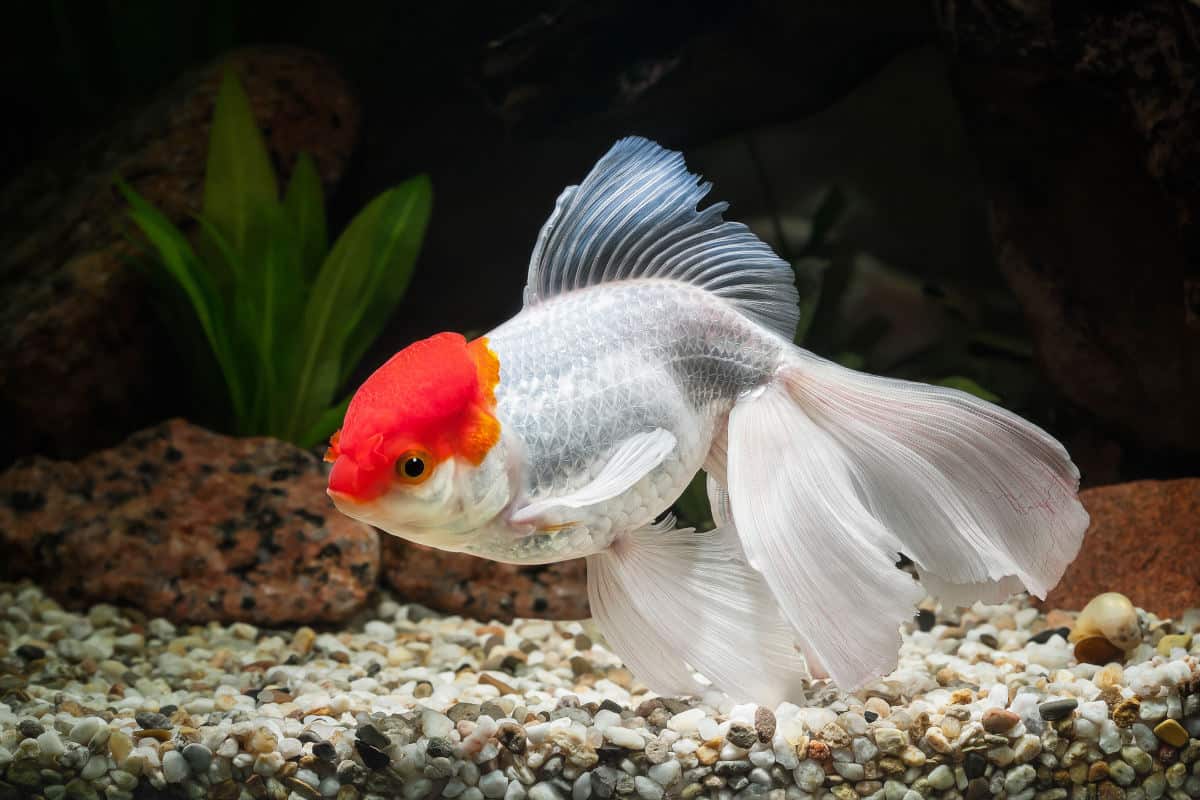Common Goldfish vs Comet Goldfish: What’s the Difference? (With Pictures)

Updated on

Common goldfish are frequently used to stock feeder tanks at pet stores, but if you’ve ever stopped and looked at the glittering display of dozens of goldfish, you may have spotted some with long, flowing fins. You may not have realized it at the time, but you were seeing a different breed of goldfish called Comet goldfish.
Comet goldfish are, unfortunately, often bred for stocking feeder tanks just like Common goldfish. Both are often passed up for more exotic fish, but Common and Comet goldfish can make exceptional pets. Both are social, intelligent, and able to learn tricks and recognize people, sounds, and patterns. Let’s explore the differences and similarities between the Common and Comet goldfish!
Visual Differences
At a Glance
- Average length (adult): 10–12 inches, up to 16 inches
- Average weight (adult): 8 ounces, up to 5 pounds
- Average Lifespan: 10–15 years, up to 40 years
- Diet: Pellets, flakes, gel food
- Water parameters: 65–75˚F, pH 7.0–8.4, 0 nitrates, nitrites, and ammonia
- Care level: Easy
- Temperament: Peaceful; Will eat any fish or invertebrates they can fit in their mouths
- Colors and patterns: Orange, red, yellow, white, black, grey, silver; Single, bi-, or tri-color in combinations except calico
- Average length (adult): 10–12 inches, up to 14 inches
- Average weight (adult): 8 ounces
- Average Lifespan: 10–14 years, up to 40 years
- Diet: Pellets, flakes, gel food
- Water parameters: 65–75˚F, pH 7.0–8.4, 0 nitrates, nitrites, and ammonia
- Care level: Easy
- Temperament: Peaceful; Will eat any fish or invertebrates they can fit in their mouths
- Colors and patterns: Orange, red, yellow, white, chocolate; Usually bi-color but can be single or tri-color in combinations except for calico; Commonly found in Sarasa, which is a red and white bi-color variant similar to koi

Common Goldfish Overview

Appearance
Common goldfish come in a variety of colors and patterns. They have slightly pointed faces and their bodies are stout and powerful with short fins. When viewed from above, they have slightly rounded bellies. This appearance is enhanced during the breeding season when females begin to produce eggs.
Keeper Considerations
Common goldfish are non-fancy goldfish and are exceptionally hardy. They can survive in tanks and ponds, even with poor water quality and low oxygen availability. With proper care, diet, and water quality, they can live for decades. Common goldfish are messy and add a large amount of bioload to their environment, meaning they excrete a large amount for their size, so this may lead to more frequent water changes to maintain water quality depending on the filtration and number of fish in the environment.
Habitat, Conditions & Lifespan
Common goldfish are not schooling fish, so they can usually live contented lives alone, although some do seem to prefer having other goldfish housed with them. Common goldfish are efficient swimmers and will sometimes race around their habitat or play in bubbles or currents, but usually can be found rooting around the substrate in search of food. They have been known to eat or uproot plants.
The Common diet can be supplemented with frozen or fresh foods like blood worms, spirulina, brine shrimp, and daphnia, as well as a wide variety of fruits and vegetables
Common goldfish should not be kept with fancy goldfish due to their speed and maneuverability allowing them to outpace fancies for food. Since these fish can live long lives, it is important to consider this when choosing a fish for your home and lifestyle.

Suitable for:
Common goldfish are suitable for indoor and outdoor fishkeeping with proper care. They are excellent fish for new fish keepers but do require time and routine care to live long, healthy lives.
Comet Goldfish Overview

Appearance
Comet goldfish are similar in appearance to Common goldfish, but they have slightly rounded faces. They have longer, more streamlined bodies and are thin when viewed from above. Females will become more round during the breeding season, though. Their name comes from their long, flowing fins that give them a comet-like appearance. All of their fins are longer than those of Common goldfish, but the biggest difference can be seen in their caudal, or tail, fin. These long fins move elegantly in the water and give these fish a fancy appearance.
Habitat, Conditions & Lifespan
Much like Common goldfish, Comets are very hardy and can withstand a poor-quality environment. Their long fins grow with the fish as it ages, and they can become torn, injured, or caught in filter intakes, so it’s best to keep a close eye on their fins and check them frequently. These fish do add a large amount to the bioload of their environment, but it is about the same amount as that of Common goldfish, so they will require the same filtration and cleaning considerations.
Comet goldfish are athletic and active, often seen dashing around their habitat. Most goldfish do better in long, narrow tanks versus round tanks, but Comets may have the highest need for a long home due to these swimming habits. They will root around the substrate in search of food but do seem to spend more time actively swimming than Common goldfish. They can keep up with Common goldfish, sometimes they are even faster, so they house together well since they can both get enough food. Be aware that Comets and Commons kept together have the potential for breeding and creating hybrid goldfish.
The Comet diet can also be supplemented with frozen or fresh foods like blood worms, spirulina, brine shrimp, and daphnia, as well as a wide variety of fruits and vegetables
Comet goldfish are another type of goldfish that should not be kept with fancy breeds. On average, Comets live slightly shorter lives than Commons, but the longest living goldfish was a Comet goldfish who lived to be 41 years old, so they have the same potential for longevity in an appropriate environment.

Suitable for:
Comet goldfish are appropriate for tanks and ponds but do require an environment with high-quality water and diet to live their longest. They are suitable for new fish keepers, but due to their delicate fins, they do best with a responsible keeper who will monitor for injury.
Which Breed is Right for You?
While it is exciting to pick a unique or exotic fish, hardy Common and Comet goldfish should not be overlooked, especially for inexperienced fish keepers. If you are interested in a fish that will figuratively greet you at the door each day, look no further than these two goldfish breeds. Their social and associative learning skills mean that they will recognize you as the person who feeds and cares for them and will be pleased to see you enter the room. Both breeds have the potential for longevity and large size, so this should be considered when looking into bringing a fish into your family.
Comets are a good choice for someone who is interested in fancy goldfish but needs something hardier. Comets and Commons are a good choice for pond fish, able to survive below-freezing temperatures by going into a semi-hibernation state called torpor. Even for an indoor setup, both breeds have few needs and do not require heaters, so a bare minimum tank with appropriate filtration and oxygenation will suffice, but it is best to create an interesting and stimulating environment with plants and hides.
Common goldfish prefer a long tank but will do better in rounded or short, bow-front tanks than Comets. So, which of these goldfish is right for you and your lifestyle? Maybe you’ve decided which breed is right for you, or maybe you will come home with both fantastic fish for your home aquarium or pond.
- Related Read: Goldfish vs Betta Fish: Which to Choose? (With Pictures)
Featured Image Credit: Commons Wikimedia, Pixabay











